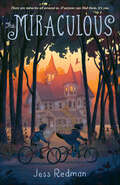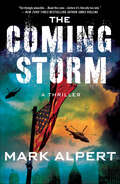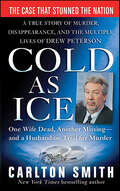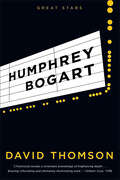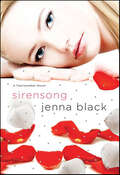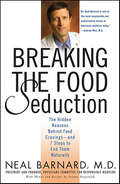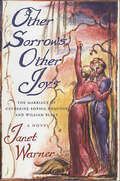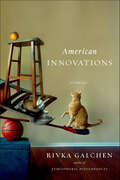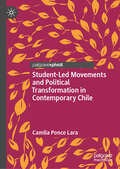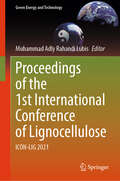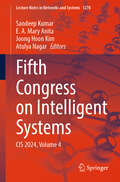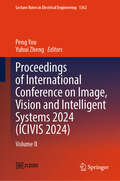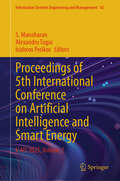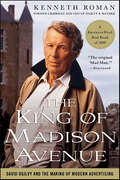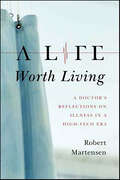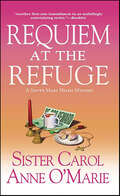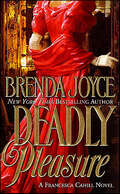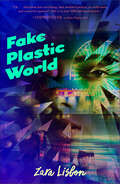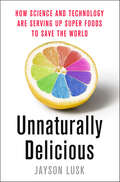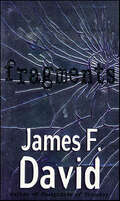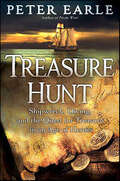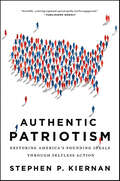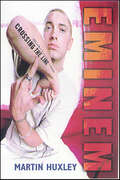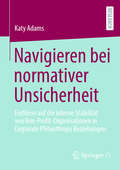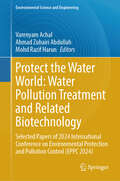- Table View
- List View
The Miraculous
by Jess RedmanAn Amazon Best Children's Book of 2019In the tradition of heartwrenching and hopeful middle grade novels such as Bridge to Terabithia comes Jess Redman's stunning debut about a young boy who must regain his faith in miracles after a tragedy changes his world.Eleven-year-old Wunder Ellis is a miracologist. In a journal he calls The Miraculous, he records stories of the inexplicable and the extraordinary. And he believes every single one. But then his newborn sister dies, at only eight days old. If that can happen, then miracles can’t exist. So Wunder gets rid of The Miraculous. He stops believing.Then he meets Faye—a cape-wearing, outspoken girl with losses of her own. Together, they find an abandoned house by the cemetery and a mysterious old woman who just might be a witch. The old woman asks them for their help. She asks them to believe. And they go on a journey that leads to friendship, to adventure, to healing—and to miracles.The Miraculous is Jess Redman’s sparkling debut novel about facing grief, trusting the unknown, and finding brightness in the darkest moments.“A stunning story expressing the complexities and mysteries of love and death in all of its light and darkness. A beautifully rendered and meaningful read for young readers asking deep questions.” —Veera Hiranandani, Newbery Honor–winning author of The Night Diary“Exquisitely crafted, serious, yet woven through with wry humor, this story’s miracles are its fierce and tender characters. I loved this extraordinary debut.” —Leslie Connor, National Book Award Finalist author of The Truth as Told by Mason ButtleThis title has common core connections
The Coming Storm: A Thriller
by Mark Alpert"This novel isn't just ripped from the headlines, it's an alarm bell ringing from the near-future, a prescient warning of where we're headed next. Read this now--before it's literally too late." - New York Times bestselling author James RollinsAmerica is on the brink of collapse, devastated by a brutal government trying to silence its citizens, in The Coming Storm, the next action-packed thriller from Mark Alpert.New York City, 2023: Rising seas and superstorms have ravaged the land. Food and electricity are scarce. A dangerous Washington regime has terrorized the city, forcing the most vulnerable and defenseless people into the flood-ravaged neighborhoods. The new laws are enforced by an army of genetically enhanced soldiers, designed to be the fiercest and cruelest of killers. Genetic scientist Dr. Jenna Khan knows too much about how these super-soldiers were engineered: by altering the DNA sequence in ways that could change the fabric of humanity.Escaping arrest and on the run, Jenna joins forces with a genetically enhanced soldier gone rogue and a Brooklyn gang kingpin to resist the government’s plan to manipulate the DNA of all Americans. The race is on to stop the evil experiment before it spreads the genetic changes…and transforms the human species forever."THE COMING STORM illustrates a terrifying near future that has a direct line of sight to the politics and crises of today...there’s no doubt the book should make us sit up and listen." - The Big Thrill
Cold as Ice: A True Story of Murder, Disappearance, and the Multiple Lives of Drew Peterson (St. Martin's True Crime Library)
by Carlton Smith***Please note: This ebook edition does not contain the photos found in the print edition.***Kathleen Savio was married to Drew Peterson for eleven years before filing for divorce in 2003. The next year, she was found dead in her bathtub. Her drowning appeared to be an accident—and for years, no one had reason to question it. But when Peterson's next wife, Stacy—thirty years younger—went missing, the tough-talking and wise-cracking former Illinois cop came under suspicion….With Stacy Peterson missing—and presumed dead—authorities exhumed Kathleen Savio's body, looking for answers. A new autopsy pointed to homicide, and a 2002 letter was revealed in which Savio wrote that Drew, "knows how to manipulate the system, and his next step is to take my children away. Or kill me instead." He was arrested for Kathleen's murder, and is a prime suspect in Stacy's disappearance, Peterson continues to protest his innocence. New York Times bestselling author Carlton Smith digs deep into the mystery behind the two Peterson wives—and sheds some light on one of the most complex crime cases in modern American history.
Humphrey Bogart (Great Stars)
by David Thomson"Look, I'm hardly pretty, he seems to say. I sound like gravel; I look rough and tough; and, honest, I don't give you the soft, foolish answers the pretty boys will give you. You may not like what I say, but you better believe it." He became a legend as "Bogie," the world-weary, wisecracking outsider, but in reality Humphrey Bogart was plagued by doubts and demons. He was born upper-class yet made his name playing mavericks, drank with the Rat Pack, and met four wives on set—including his great love, Lauren Bacall—yet always mistrusted stardom. Here David Thomson, one of film's most provocative writers, reveals the man behind cinema's greatest icon.
Sirensong (A Faeriewalker Novel)
by Jenna BlackWhen Dana is invited to Faerie to be officially presented at the Seelie Court, it's no easy decision. After all, everyone knows Titania, the Seelie Queen, wants her dead. But Titania claims not to be the one behind the death threats; and her son, Prince Henry, makes the decision a whole lot easier when he suggests Dana might be arrested for (supposedly) conspiring with her aunt Grace to usurp the Seelie throne. So she and her father better do as they're told . . . The journey through Faerie is long—and treacherous. Dana thought it would be a good idea to have friends along, but her sort-of-boyfriend, Ethan, and her bodyguard's son, Keane, just can't seem to get along, and Kimber's crush on Keane isn't making things any easier. When a violent attack separates Dana from their caravan, the sexy Erlking saves her just in the nick of time . . . and makes it clear that he hasn't given up on making her his own. Arriving at Titania's beautiful palace should be a relief. But Dana is soon implicated in an assassination attempt against Titania's granddaughter, and is suddenly a fugitive, forced to leave her father behind as she and her friends flee for their lives. Will she be able to prove her innocence before the forces of the Seelie Court—or, worse, the Erlking—catch up with her? And will she save her father before he pays the ultimate price in her stead? Sirensong is book three in Jenna Black's enchanting Faeriewalker series.
Breaking the Food Seduction: The Hidden Reasons Behind Food Cravings—and 7 Steps to End Them Naturally
by Neal BarnardJennifer is a thirty-four-year-old bank manager. She's managed her education, her career, her finances--and her customers' money--she can't seem to handle this darn little chocolate in a shiny wrapper. . . Whether you're drawn to chocolate, cookies, potato chips, cheese, or burgers and fries, we all have foods we can't seem to resist--foods that sabotage our best efforts to lose weight and improve our health.These foods are winning the battle--but that's because we're fighting it in the wrong place. As physician and leading health researcher Dr. Neal Barnard explains in this groundbreaking book, banishing these cravings is not a question of willpower or psychology--it's a question of biochemistry. Based on the author's research and that of other leading investigators at major universities, Breaking the Food Seduction reveals the diet and lifestyle changes that can break these stubborn craving cycles. Using everyday examples, questionnaires, and practical tips, the book delivers:- Fascinating new insights into the chemical reasons behind your cravings- Seven simple steps to break craving cycles and tame your appetite- Important advice for kids' sugar cravings and how to halt them- A three-week kick-start program - One hundred delicious, satisfying recipes that help your body break the spell of problem foods and put you on the path to weight loss, better health, and greater well-beingThis accessible and practical book is essential reading for anyone who wants to lose weight, lower cholesterol, feel more energetic, and get control of their health once and for all.
Other Sorrows, Other Joys: A Novel
by Janet WarnerThis is the imagined life of a woman who really lived in the late Eighteenth Century - Catherine Sophia Boucher, called Kate - wife of the English poet and artist, William Blake. If you read between the lines of his poetry and letters, this is a story you might find. Other Sorrows, Other Joys weaves fact and fiction to tell the story of Kate's search for identity in the shadow of a man who can "see a World in a Grain of Sand and Heaven in a Wild Flower." Conventional, innocent Kate struggles to understand the world around her in the midst of her visionary husband's free-thinking crusades for freedom in religion, in politics, in love. Janet Warner's original novel dramatically recreates the story of a poet and his spiritual companion and the mystic visions that haunt them both throughout their lives.As Kate works as Blake's assistant, printing and coloring his designs, she witnesses the psychic powers that distract William from earning a living. She endures the loss of a long-awaited child, Blake's fascination for gifted women, and his frightening trial for treason. Through Kate's eyes, we meet a parade of people prominent in 18th Century artistic circles during the time of the French Revolution, such as the feminist Mary Wollstonecraft, Swiss painter Henry Fuseli, and the publisher Joseph Johnson - people whose intertwined lives were as unconventional as any Bohemians of a later time. Amidst these turbulent personal and political events, Warner reveals the compelling drama of Kate and William's marriage that survived it all.
American Innovations: Stories
by Rivka GalchenA BRILLIANT NEW COLLECTION OF SHORT STORIES FROM THE "CONSPICUOUSLY TALENTED" (TIME) RIVKA GALCHENWinner of the Danuta Gleed Literary Award A New York Times Book Review Notable BookChosen as one of fifteen remarkable books by women that are shaping the way we read and write in the 21st century by the book critics of The New York TimesIn one of the intensely imaginative stories in Rivka's Galchen's American Innovations, a young woman's furniture walks out on her. In another, the narrator feels compelled to promise to deliver a takeout order that has incorrectly been phoned in to her. In a third, the petty details of a property transaction illuminate the complicated pains and loves of a family. The tales in this groundbreaking collection are secretly in conversation with canonical stories, reimagined from the perspective of female characters. Just as Wallace Stevens's "Anecdote of the Jar" responds to John Keats's "Ode on a Grecian Urn," Galchen's "The Lost Order" covertly recapitulates James Thurber's "The Secret Life of Walter Mitty," while "The Region of Unlikeness" is a smoky and playful mirror to Jorge Luis Borges's "The Aleph." The title story, "American Innovations," revisits Nikolai Gogol's "The Nose." By turns realistic, fantastical, witty, and lyrical, these marvelously uneasy stories are deeply emotional and written in exuberant, pitch-perfect prose. Whether exploring the tensions in a mother-daughter relationship or the finer points of time travel, Galchen is a writer like none other today.
Student-Led Movements and Political Transformation in Contemporary Chile
by Camila Ponce LaraThis book examines how Chilean student movement leaders achieved unprecedented political power in the post-dictatorship era, culminating in Gabriel Boric's presidency and prominent roles for other former activists. Through detailed analysis, it traces the evolution of student movements from post-dictatorship resistance to institutional governance, revealing strategies that enabled this remarkable shift from protest to executive leadership.The chapters progress methodologically from theoretical frameworks on youth activism and social movement theory to case studies of key mobilizations including the 2001 Mochilazo, 2006 Pingüino Movement, and transformative 2011 protests. The work explores how different political trajectories—conservative, breakthrough, and emerging—shape young activists' paths to power.By analyzing this unprecedented political transformation, the book offers vital insights for understanding contemporary social movements across Latin America and beyond. It provides innovative conceptual tools for scholars, activists, and policymakers interested in political change, youth leadership, and the dynamic relationship between street protest and institutional power.
Proceedings of the 1st International Conference of Lignocellulose: ICON-LIG 2021 (Green Energy and Technology)
by Muhammad Adly Rahandi LubisThis book presents the selected papers from the 1st International Conference of Lignocellulose, held as a virtual conference in Bogor, Indonesia, on September 13—14, 2021. The papers include contributions from researchers, scientists, academia, and practitioners covering topics from the field of biomass conversion, bio-based smart materials, forest, and environment, enhancing mitigation for climate change, radar and atmospheric science, and socio-economy in sustainable development goals. This event was organized by Japan Society for the Promotion of Science (JSPS) Alumni Association of Indonesia in collaboration with Research Center for Biomaterials, Indonesian Institute of Sciences, Indonesia.
Fifth Congress on Intelligent Systems: CIS 2024, Volume 4 (Lecture Notes in Networks and Systems #1278)
by Sandeep Kumar Atulya Nagar Joong Hoon Kim E. A. Mary AnitaThis book is a collection of selected papers presented at the Fifth Congress on Intelligent Systems (CIS 2024), organized by CHRIST (Deemed to be University), Bangalore, India, under the technical sponsorship of the Soft Computing Research Society, India, during September 4–5, 2024. The book covers high-quality research articles in the fields of soft computing, machine vision, robotics, computational intelligence, artificial intelligence, signal and image processing, data science techniques, and their real-world applications which are some of the recent advancements in the real-world technologies.
Proceedings of International Conference on Image, Vision and Intelligent Systems 2024: Volume II (Lecture Notes in Electrical Engineering #1362)
by Peng You Yuhui ZhengThis book constitutes the refereed proceedings of ICIVIS2024, held in Xining, China, in June 2024. This book provides a comprehensive collection of cutting-edge research and innovative solutions in image, vision and intelligent systems. The primary audience consists of academic researchers, industry professionals, and graduate students working in the domains of image, vision, and intelligent systems. This publication serves as an essential resource for those seeking to stay at the forefront of their respective fields, expand their knowledge, and explore new avenues for research and development.
Proceedings of 5th International Conference on Artificial Intelligence and Smart Energy: ICAIS 2025, Volume 2 (Information Systems Engineering and Management #42)
by Isidoros Perikos Alexandru Tugui S. ManoharanThis book discusses the latest developments in computing techniques that power smart energy and sustainable solutions. Over the last few years, artificial intelligence (AI) has been more deeply embedded in our lives, revolutionizing industries and communication. Intelligent computing models are now transforming traditional energy applications in this digital age through smart automation, optimization, and adaptation. The book addresses major facets of intelligent computing and communication technologies, such as intelligent data analysis, predictive modeling, optimization, neural networks, AI, machine learning, deep learning, and the Internet of Things (IoT). All these technologies are discussed in practical applications, e.g., smart cities and smart industries, their transformative possibilities.
The King of Madison Avenue: David Ogilvy and the Making of Modern Advertising
by Kenneth RomanFrom the former CEO of Ogilvy & Mather, the first biography of advertising maverick David OgilvyFamous for his colorful personality and formidable intellect, David Ogilvy left an indelible mark on the advertising world, transforming it into a dynamic industry full of passionate, creative individuals. This first-ever biography traces Ogilvy's remarkable life, from his short-lived college education and undercover work during World War II to his many successful years in New York advertising. Ogilvy's fascinating life and career make for an intriguing study from both a biographical and a business standpoint. The King of Madison Avenue is based on a wealth of material from decades of working alongside the advertising giant, including a large collection of photos, memos, recordings, notes, and extensive archives of Ogilvy's personal papers. The book describes the creation of some of history's most famous advertising campaigns, such as:* "The man in the Hathaway shirt" with his aristocratic eye patch* "The man from Schweppes is here" with Commander Whitehead, the elegant bearded Brit, introducing tonic water (and "Schweppervesence") to the U.S.* Perhaps the most famous automobile headline of all time--"At 60 miles an hour the loudest noise in this new Rolls-Royce comes from the electric clock."* "Pablo Casals is coming home--to Puerto Rico." Ogilvy said this campaign, which helped change the image of a country, was his proudest achievement.* And his greatest (if less recognized) sales success--"DOVE creams your skin while you wash." Roman also carries Ogilvy's message into the present day, showing the contemporary relevance of the bottom-line focus for which his business ventures are remembered, and how this approach is still key for professionals in the modern advertising world.
A Life Worth Living: A Doctor's Reflections on Illness in a High-Tech Era
by Robert MartensenCritical illness is a fact of life. Even those of us who enjoy decades of good health are touched by it eventually, either in our own lives or in those of our loved ones. And when this happens, we grapple with serious and often confusing choices about how best to live with our afflictions. A Life Worth Living is a book for people facing these difficult decisions. Robert Martensen, a physician, historian, and ethicist, draws on decades of experience with patients and friends to explore the life cycle of serious illness, from diagnosis to end of life. He connects personal stories with reflections upon mortality, human agency, and the value of "cutting-edge" technology in caring for the critically ill. Timely questions emerge: To what extent should efforts to extend human life be made? What is the value of nontraditional medical treatment? How has the American health-care system affected treatment of the critically ill? And finally, what are our doctors' responsibilities to us as patients, and where do those responsibilities end? Using poignant case studies, Martensen demonstrates how we and our loved ones can maintain dignity and resilience in the face of life's most daunting circumstances.
Requiem at the Refuge (Sister Mary Helen Mysteries)
by Carol Anne O'Marie"A San Francisco nun... author [O’Marie] evokes convent life in the 90s with simple reverence and gentle humor." - Publishers WeeklySister Mary Helen is dismayed when, after the unexpected death of Sister Cecilia, the president of Mount St. Francis College, Sister Patricia is appointed the post. Sister Mary Helen is not in the new president's best graces and feels she surely will be asked to retire. But the chance to volunteer at a drop-in center for abused women and serve on the board quite revives Sister Mary Helen's flagging spirits -- until a young woman who frequents the center is murdered.
Deadly Pleasure (The Francesca Cahill Novels)
by Brenda JoyceBrenda Joyce has enthralled millions of readers with her New York Times bestselling novels. Now, join us in the next chapter of her unforgettable storytelling: the Francesca Cahill novels. Step into the glittering world of New York City's high society at the turn of the last century, where murder and pleasure are one and the same, and love becomes the ultimate weapon...Francesca Cahill comes from one of New York's best families. Her mother is a leading socialite, her father, a millionaire. Their expectations for their daughter are simple-- marry well, and soon. But the intrepid and self-styled "Crime-Solver Extraordinaire" has other plans...Francesca discovered she had a penchant for sleuthing when she met Rick Bragg, New York City's powerful and enigmatic Police Commissioner. Together, they solved what was known as the crime of the century. Now, their paths are destined to come together once again, but this time far more dangerously and fatefully. For Francesca is tempted to give in to the desire she and Rick have been resisting. And when Bragg's arch-rival Calder Hart arrives in town, a respectable man is suddenly found dead, and now murder is the name of the game...
Fake Plastic World
by Zara LisbonYouth, beauty, and the perils of fame combine in Zara Lisbon's Fake Plastic World, the suspenseful sequel to Fake Plastic Girl.How badly do you want to be famous? What—or who—would you sacrifice?These are the questions Justine Childs is forced to reckon with as the main suspect in the murder of It-girl Eva-Kate Kelly. Not long ago, Eva-Kate drew Justine into her orbit before meeting her untimely end in a Venice Beach canal. Prosecutors and the public want to know: Did Justine, now a social media darling in her own right, kill her celebrity best friend? Can anyone be trusted to tell the truth? Justine has always wanted people to know her name—but not all notoriety is created equal.
Unnaturally Delicious: How Science and Technology Are Serving Up Super Foods to Save the World
by Jayson LuskThe food discussion in America can be quite pessimistic. With high obesity rates, diabetes, climate change, chemical use, water contamination, and farm animal abuse, it would seem that there wasn't very much room for a positive perspective. The fear that there just isn't enough food has expanded to new areas of concern about water availability, rising health care costs, and dying bees.In Unnaturally Delicious, Lusk makes room for optimism by writing the story of the changing food system, suggesting that technology and agriculture can work together in a healthy and innovative way to help solve the world's largest food issues and improve the farming system as we know it.This is the story of the innovators and innovations shaping the future of food. You’ll meet an ex-farmer entrepreneur whose software is now being used all over the world to help farmers increase yields and reduce nutrient runoff and egg producers who’ve created new hen housing systems that improve animal welfare at an affordable price. There are scientists growing meat in the lab. Without the cow. College students are coaxing bacteria to signal food quality and fight obesity. Nutrient enhanced rice and sweet potatoes are aiming to solve malnutrition in the developing world. Geneticists are creating new wheat varieties that allow farmers sustainably grow more with less. And, we’ll learn how to get fresh, tasty, 3D printed food at the touch of a button, perhaps even delivered to us by a robotic chef. Innovation is the American way. Thomas Jefferson, George Washington Carver, and John Harvey Kellogg were food and agricultural entrepreneurs. Their delicious innovations led to new healthy, tasty, convenient, and environmentally friendly food. The creations were unnaturally delicious. Unnatural because the foods and practices they fashioned were man-made solutions to natural and man-made problems. Now the world is filled with new challenges changing the way we think about food. Who are the scientists, entrepreneurs, and progressive farmers who meet these challenges and search for solutions? Unnaturally Delicious has the answers.
Fragments
by James F. DavidA team of psychologists has gathered in a small college town to conduct a revolutionary experiment: To find five "savants" with extreme and diverse aptitudes, in order to create a sixth composite intelligence using new cybernetic technology. The first experiments show promise, but a terrifying secret from the past will transform the project in ways the researchers never anticipated--and infect the newborn intelligence with a catastrophic thirst for vengeance."Its thought-provoking subject notwithstanding, David's tale is an action-packed no-brainer full of guilty pleasures for even the most cerebral reader." - Publishers WeeklyAt the Publisher's request, this title is being sold without Digital Rights Management Software (DRM) applied.
Treasure Hunt: Shipwreck, Diving, and the Quest for Treasure in an Age of Heroes
by Peter Earle"A remarkable book, in which a very wide spectrum of human behavior is on show---from colossal gullibility on the one hand, to extraordinary ingenuity and determination on the other." —The Daily Telegraph (UK)Treasure Hunt is the story of an obsession. Rumors of Spanish treasure, or gold and silver at the bottom of the sea, have been a part of maritime lore for centuries. In 1687, Captain William Phips brought back to port an incredible cargo---nearly forty tons of silver and gold---the treasure of the Spanish galleon Concepción, wrecked over forty years before on a coral reef in the middle of the ocean. The unimaginable had become real, and the great treasure-hunting boom had begun. Soon after Phips's success, there were numerous expeditions that meant to emulate his stunning achievement. During that same time there was also a boom in the invention of crude and often very dangerous diving equipment. Many of these new projects were promoted on the infant stock market, where gambling and treasure hunting became closely connected with the birth of modern capitalism. By the eighteenth and nineteenth centuries, treasure hunting had become a professional occupation, with a new breed of diver emerging. Much of their time was spent salvaging the wrecks of English and Dutch East-Indiamen carrying treasure to finance business in Asia. Ever since, men have been prepared to risk life and fortune in the search for underwater riches. The author of numerous books of maritime history, including The Pirate Wars and The Sack of Panamá, world-renowned historian Peter Earle returns with an extraordinary and little-known history---of outstanding bravery, of exceptional recklessness, and above all, of the unquenchable lust for treasure.
Authentic Patriotism: Restoring America's Founding Ideals Through Selfless Action
by Stephen P. KiernanAuthentic Patriotism presents a provocative, inspiring account of our neglected American ideals and the people who are living them today.Patriotism has become a loaded word: one that is wielded against people with whom we might disagree, or whose cultural origins don't match our own. But our founding fathers--Washington, Jefferson, Adams, and others--saw patriotism as a dynamic force: an act of service, in an evolving nation that defined its purpose by offering all people a better way of life. In Authentic Patriotism, author and award-winning journalist Stephen P. Kiernan explores the original ideals that have been lost in our current climate, where war and economic turmoil have eroded our sense of civic obligation. Kiernan describes "a nation adrift," out of touch with its origins--and then introduces a range of inspiring people who have revived our national purpose by taking action: - The out-of-work college graduate who led an economic and environmental renewal of her blighted home community.- The retired executive who pioneered a revolutionary concept in health care for people without insurance.- The minister who created a legendary choir, with the goal of uniting children of different races, genders, and classes in one voice.- The family who donated their daughter's heart, so that another might live. These and other "New Americans" are profiled in a book that offers hope, ideas, examples, and practical resources for readers who want to renew the American spirit.
Eminem: Crossing the Line
by Martin Huxley"God sent me to piss the world off," Eminem boasts on his breakthrough hit "My Name Is." A grandiose claim to be sure, but it's hard to imagine another rapper generating as much controversy and outrage as this bleach-blonde Detroit MC outlaw while still selling millions of records and becoming a hero to pop fans and hardcore hip-hop purists alike. The sharp-tongued product of crushing poverty and an unstable homelife, Eminem is much more than the goofy smartass he usually portrays himself as. Beyond the artist's inventive rhyming skills and appealingly warped lyrical persona, the multi-platinum major-label albums The Slim Shady LP and The Marshall Mathers LP present a dark, psychologically complex character whose vivid, vengeful rhymes embody a timely collision of Midwestern white trash and urban hip-hop cultures, while portraying an unpredictably violent yet absurdly hilarious world. Adopting the cartoonish yet unsettling persona of Slim Shady, Eminem spins colorfully absurd narratives involving sadistic violence while reflecting the tortured psyche of a deeply conflicted character whose real-life pain lurks beneath the surface of his outrageous alter ego.It's those contradictions that help make Eminem a uniquely compelling artist whose primal appeal transcends boundaries of race and musical genre. Eminem: Crossing the Line, the first biography ever written of this unique pop-culture icon, offers a fascinating peek into the strange and twisted world of Slim Shady.
Navigieren bei normativer Unsicherheit: Einflüsse auf die interne Stabilität von Non-Profit-Organisationen in Corporate Philanthropy Beziehungen
by Katy AdamsObwohl Beziehungen zwischen Unternehmen und Non-Profit-Organisationen weit verbreitet sind, ist wenig darüber bekannt, welche Auswirkungen sie auf die interne Stabilität der Non-Profit-Organisationen haben. Dieses Buch zeigt nicht nur den Bedarf an solchem Wissen, sondern auch die vielfältigen und vielstimmigen Einflüsse auf die Wahrnehmung einer solchen Beziehung durch Non-Profit-Mitarbeitende und die daraus resultierende Bindung zwischen ihnen und ihrer Organisation. Auf diese Weise wird deutlich, dass die langfristigen Folgen der Beziehungen zwischen Unternehmen und Non-Profit-Organisationen in der Verantwortung aller Beteiligten und des gesamten Sektors liegen.
Protect the Water World: Selected Papers of 2024 International Conference on Environmental Protection and Pollution Control (EPPC 2024) (Environmental Science and Engineering)
by Varenyam Achal Ahmad Zuhairi Abdullah Mohd Razif HarunThis book unveils the advancements in water pollution analysis and its biological treatment technology and provides valuable research and experience for engineers and scholars. On March 22, 2024, in the United Nations World Water Development Report, the theme of this year's conference, "Water for Promoting Prosperity and Peace," aligns with Global Water Partnerships' long-standing mission and vision of integrated water resources management. Currently, around half of the world's population faces severe water scarcity for at least part of the year, and a quarter of the global population experiences "extremely high" water stress. Meanwhile, global freshwater usage is growing at a rate slightly below 1% annually. Hence, the protection of water resources and pollution control, particularly the renewal and management of freshwater resources, deserve significant attention. Emerging pollutants of concern include per- and polyfluoroalkyl substances (PFAS), pharmaceuticals, hormones, industrial chemicals, detergents, cyanotoxins, and nanomaterials. High concentrations of antimicrobial agents have been found worldwide, originating from inadequately treated household wastewater, livestock, and aquaculture. Biological treatment technology for water pollution uses microorganisms to break down pollutants into harmless or less toxic substances, becoming an important means of addressing water pollution. Its advantages lie in low cost, adaptability, and the ability to effectively treat various organic pollutants, including hydrocarbons, pharmaceuticals, and pesticides. However, the effectiveness of this technology depends on the selection of appropriate microbial strains and the optimization of treatment conditions (such as temperature, pH, and nutrients). In the aspect of water pollution analysis, accurate detection of the types and concentrations of pollutants is a prerequisite for management and remediation. Modern instruments, such as gas chromatography-mass spectrometry (GC-MS) and liquid chromatography-mass spectrometry (LC-MS), can identify and quantify trace pollutants in complex water bodies. Additionally, new-generation sensing technologies and biological detection tools, like DNA microarrays and gene sequencing technologies, enable rapid detection of specific pollutants and reveal microbial community responses to pollutants. These technologies can effectively target and treat heavy industrial and chemical pollution, thereby protecting water environmental safety. This book aims to facilitate the exchange of scientific information among scholars from leading universities, research centers, and high-tech enterprises around the world. This book is highly beneficial to scholars, engineers, and researchers in the fields of environmental engineering and water pollution.
